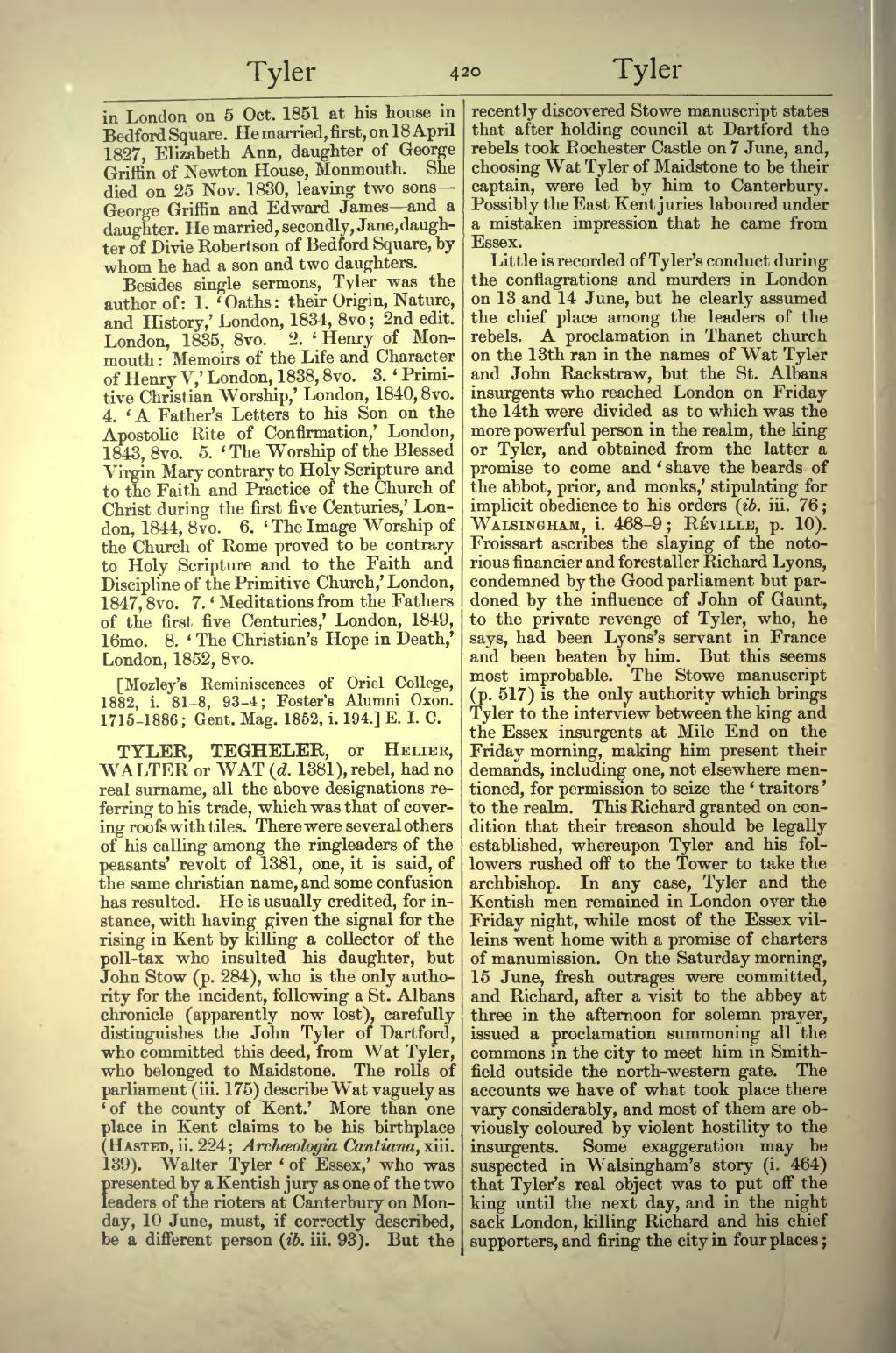in London on 5 Oct. 1851 at his house in Bedford Square. He married, first, on 18 April 1827, Elizabeth Ann, daughter of George Griffin of Newton House, Monmouth. She died on 25 Nov. 1830, leaving two sons—George Griffin and Edward James—and a daughter. He married, secondly, Jane, daughter of Divie Robertson of Bedford Square, by whom he had a son and two daughters.
Besides single sermons, Tyler was the author of: 1. ‘Oaths: their Origin, Nature, and History,’ London, 1834, 8vo; 2nd edit. London, 1835, 8vo. 2. ‘Henry of Monmouth: Memoirs of the Life and Character of Henry V,’ London, 1838, 8vo. 3. ‘Primitive Christian Worship,’ London, 1840, 8vo. 4. ‘A Father's Letters to his Son on the Apostolic Rite of Confirmation,’ London, 1843, 8vo. 5. ‘The Worship of the Blessed Virgin Mary contrary to Holy Scripture and to the Faith and Practice of the Church of Christ during the first five Centuries,’ London, 1844, 8vo. 6. ‘The Image Worship of the Church of Rome proved to be contrary to Holy Scripture and to the Faith and Discipline of the Primitive Church,’ London, 1847, 8vo. 7. ‘Meditations from the Fathers of the first five Centuries,’ London, 1849, 16mo. 8. ‘The Christian's Hope in Death,’ London, 1852, 8vo.
[Mozley's Reminiscences of Oriel College, 1882, i. 81–8, 93–4; Foster's Alumni Oxon. 1715–1886; Gent. Mag. 1852, i. 194.]
TYLER, TEGHELER, or Helier, WALTER or WAT (d. 1381), rebel, had no real surname, all the above designations referring to his trade, which was that of covering roofs with tiles. There were several others of his calling among the ringleaders of the peasants' revolt of 1381, one, it is said, of the same christian name, and some confusion has resulted. He is usually credited, for instance, with having given the signal for the rising in Kent by killing a collector of the poll-tax who insulted his daughter, but John Stow (p. 284), who is the only authority for the incident, following a St. Albans chronicle (apparently now lost), carefully distinguishes the John Tyler of Dartford, who committed this deed, from Wat Tyler, who belonged to Maidstone. The rolls of parliament (iii. 175) describe Wat vaguely as ‘of the county of Kent.’ More than one place in Kent claims to be his birthplace (Hasted, ii. 224; Archæologia Cantiana, xiii. 139). Walter Tyler ‘of Essex,’ who was presented by a Kentish jury as one of the two leaders of the rioters at Canterbury on Monday, 10 June, must, if correctly described, be a different person (ib. iii. 93). But the recently discovered Stowe manuscript states that after holding council at Dartford the rebels took Rochester Castle on 7 June, and, choosing Wat Tyler of Maidstone to be their captain, were led by him to Canterbury. Possibly the East Kent juries laboured under a mistaken impression that he came from Essex.
Little is recorded of Tyler's conduct during the conflagrations and murders in London on 13 and 14 June, but he clearly assumed the chief place among the leaders of the rebels. A proclamation in Thanet church on the 13th ran in the names of Wat Tyler and John Rackstraw, but the St. Albans insurgents who reached London on Friday the 14th were divided as to which was the more powerful person in the realm, the king or Tyler, and obtained from the latter a promise to come and ‘shave the beards of the abbot, prior, and monks,’ stipulating for implicit obedience to his orders (ib. iii. 76; Walsingham, i. 468–9; Réville, p. 10). Froissart ascribes the slaying of the notorious financier and forestaller Richard Lyons, condemned by the Good parliament but pardoned by the influence of John of Gaunt, to the private revenge of Tyler, who, he says, had been Lyons's servant in France and been beaten by him. But this seems most improbable. The Stowe manuscript (p. 517) is the only authority which brings Tyler to the interview between the king and the Essex insurgents at Mile End on the Friday morning, making him present their demands, including one, not elsewhere mentioned, for permission to seize the ‘traitors’ to the realm. This Richard granted on condition that their treason should be legally established, whereupon Tyler and his followers rushed off to the Tower to take the archbishop. In any case, Tyler and the Kentish men remained in London over the Friday night, while most of the Essex villeins went home with a promise of charters of manumission. On the Saturday morning, 15 June, fresh outrages were committed, and Richard, after a visit to the abbey at three in the afternoon for solemn prayer, issued a proclamation summoning all the commons in the city to meet him in Smithfield outside the north-western gate. The accounts we have of what took place there vary considerably, and most of them are obviously coloured by violent hostility to the insurgents. Some exaggeration may be suspected in Walsingham's story (i. 464) that Tyler's real object was to put off the king until the next day, and in the night sack London, killing Richard and his chief supporters, and firing the city in four places;
